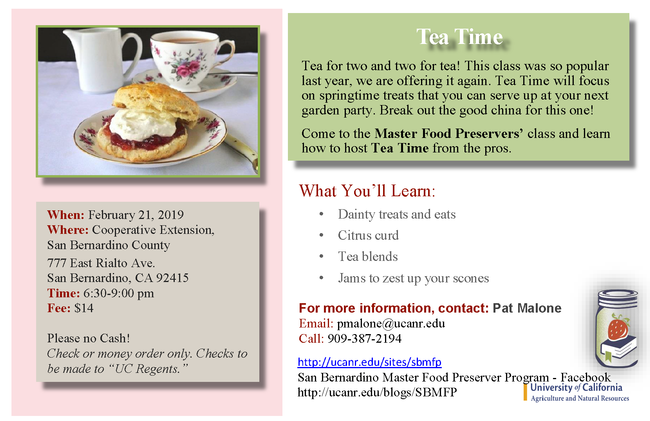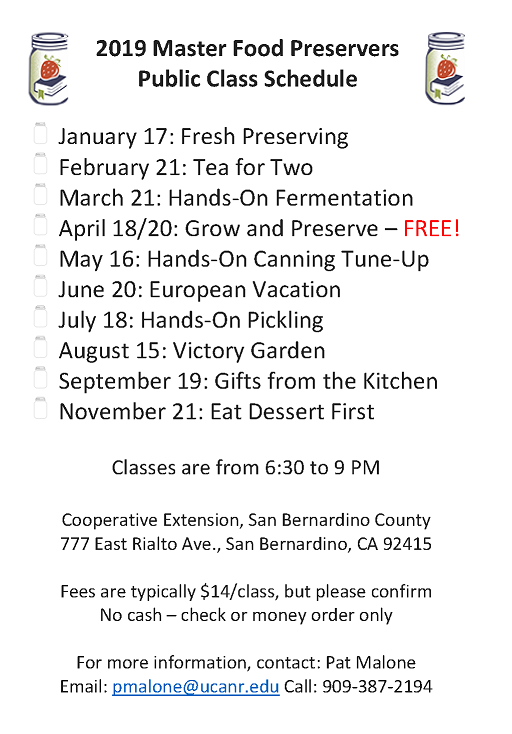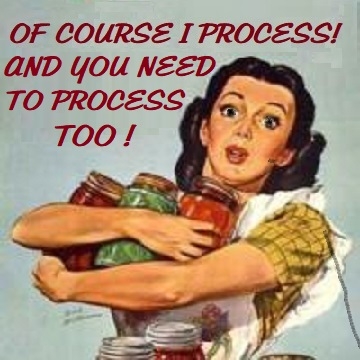- Author: Lauria Watts
Hear Ye, Hear Ye! The Teatime class is coming up! So popular last year that it is being presented again. Come and enjoy learning about go-withs when having a cup of tea.
As an added bonus for planning your future attendance is a list of 2019's classes with the San Bernardino Master food Preservers. Do any look interesting? Put your favorites on your calendar right now!
Remember that the Grow and Preserve and Gifts from the kitchen are especially highly attended, so make reminder to yourself to reserve your classes few weeks before each, ok?
- Author: Lauria Watts
Have you ever been asked why a jam or jelly needs to be processed to store on the shelf? Has someone said, "Well, I always invert my jars. What's wrong with tha?" or "My Grandma use to just pour the jelly into jars and slap lids on 'em and that's what I do! Why not?" Were you able to give them good reasons why they need to process their jams or jellies?
This post direct from our recommended resource: the NCHFP (aka the National Center for Home Food Preservation, hosted by the University of Georgia), is a nice explanation on why it is recommended to process jams and jellies.
Also nice to note is that food safety, while a big reason, is not the only reason to process. So take a gander and let me know what you think!
Why do you recommend processing jams and jellies?
- Author: L. Watts
What a meeting! You missed it!
Market! Link! Social Media! Pictures! SB County expectations! Gray-scale flyers! Photo album! Out-reach! Class opportunities! Great ideas, good food (of course we had good food!)
These are just a few of the things we brain-stormed in the Marketing Brainstorming meeting we had this past Saturday. There was a good turn-out at Susan Israel's very nice house—thank you Susan for hosting.
Check out some pics:
Complete with Post-its! You cannot see all the ideas flying around here, but look at the number of post-its on the windo in the back and you will get an idea of the number. And there were even more by the end of the meeting.
This picture did not include one of Suzy's dogs that climbed up on the back of the couch and and licked Lane's head to get his attention!--all very sweet dogs.
There were a lot of very good Ideas to help publicize the MFP program. Many things to think about and start to take action on.
For starters, one easy Idea for you all: If you post anything, anywhere on the web as a response to a food/canning article, item, blog, picture or such, please include in your signature “Master Food Preserver of San Bernardino County.” If you have a webpage of any sort, please link to us ! This will help us to come up in results for searches about canning/food preservation. If you can make this a link to our Home page or blog or Facebook page it would be even better. If you need help with this just e-mail me!
COMING UP: Brining, smoking a bird for T-Day, from Darrell Fluman. It's a good one so don't miss it.
Now I leave you with the recipe for the delicious Meyer Lemon Polenta cake that Suzy served at our meeting. Not a preservation recipe, but it uses optional candied lemon slices and we TALKED about canning stuff!!!
Meyer Lemon Almond Cake
http://www.sfgate.com/recipes/article/Meyer-Lemon-Almond-Cake-6036459.php
Serves 8-10
This cake pairs the bright flavor of Meyer lemons with a moist, buttery crumb made of almond flour. This is naturally gluten-free (as long as you use gluten-free flour blend to coat the pan). It can be gussied up with a topping of candied lemons, or served without.
Tips From Suzy: The recipe is hard to follow. I've learned to do some prep first: A small bowl of just the almond flour, a small bowl of the lemon zest/lemon juice/vanilla, and a small bowl of polenta (just cornmeal--don't tell anybody)/baking powder/salt/cardamom powder. They get mixed in with the butter/sugar/egg mixture in that order. And any lemons will do.
The cake:
8 ounces (2 sticks) unsalted butter, softened
1 to 2 teaspoons all-purpose flour or gluten-free flour blend
1 cup sugar
2 cups almond flour
3 large eggs
½ teaspoon vanilla extract
¼ cup Meyer lemon juice (about 1 large lemon)
2 tablespoons finely grated Meyer lemon zest (about 2 large lemons)
½ cup medium-grind polenta (cornmeal!)
1 teaspoon baking powder
¼ teaspoon kosher salt
¼ teaspoon ground cardamom
Candied lemons (optional):
1½ cups sugar
2/3 cup water
3 to 4 medium Meyer lemons (about 10 to 14 ounces), sliced 1/8-inch thick, seeds removed
For the cake: Preheat the oven to 325 degrees, and place a rack in the middle.
Place the butter in a large mixing bowl or the bowl of a stand mixer fitted with the paddle attachment; set aside. Use the butter wrappers to grease the inside of a 9-inch springform pan and sprinkle with the flour, rotating to coat the bottom and sides of the pan; discard excess flour. Cut a circle of parchment paper to fit the bottom, place inside the pan and set aside.
Add the sugar to the butter; mix at medium-high speed until light and fluffy, about 4 minutes, scraping down the sides of the bowl once or twice. Add the almond flour and mix slowly to combine.
Add the eggs, one at a time, beating thoroughly to combine, scraping down the sides of the bowl, before adding the next. The batter should have a light, mousse-like texture.
Remove the bowl from the mixer. Using a large spoon or rubber spatula, gently fold in the vanilla, lemon juice and zest. Add the polenta, baking powder, salt and cardamom, continuing to fold carefully.
Spoon the batter into the prepared pan and smooth out to the edges. Set the cake pan on a rimmed baking sheet and bake 45-50 minutes, until the top is golden brown and the center is set.
Remove the cake from the oven and let sit 10 minutes. Run a butter knife around the edge of the cake to loosen, then remove the sides of the pan. Leave the cake on the bottom of the springform pan, place on a rack and let cool. The cake can be made a day ahead; loosely wrap or place in a cake carrier and store at room temperature.
For the candied lemons: Combine the sugar and water in a shallow saucepan and heat over medium-high until the sugar dissolves and the mixture comes to a strong simmer. Working in batches, add the lemon slices and continue to simmer, turning the slices occasionally, until the peels turn translucent, about 6-7 minutes, depending on the thickness of the slices. Remove from heat and let cool. The candied lemons can be made a day or two ahead; refrigerate in the syrup.
To finish the cake: Remove the candied lemon slices from the syrup and blot with paper towels. Overlap the slices atop the cake.
Note: Reserve the remaining syrup to mix with mineral water or club soda for a light spritzer, or to add to a citrus-based cocktail that calls for simple syrup. Or, use it to sweeten lemonade.







